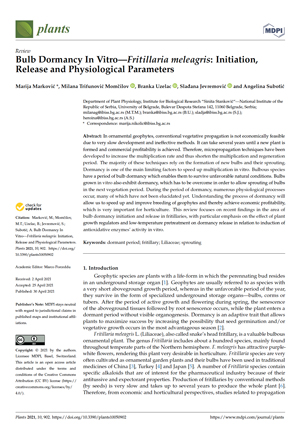NEWS 2021
Bulb Dormancy In Vitro—Fritillaria meleagris: Initiation, Release and Physiological Parameters
Marija MARKOVIĆ, Milana Trifunović MOMČILOV, Branka UZELAC, Slađana JEVREMOVIĆ, Angelina SUBOTIĆ
Plants 10(5), 902 (2021)
https://doi.org/10.3390/plants10050902
Department of Plant Physiology, Institute for Biological Research “Siniša Stanković“—National Institute of the Republic of Serbia, University of Belgrade, Bulevar Despota Stefana 142, 11060 Belgrade, Serbia
Abstract
In ornamental geophytes, conventional vegetative propagation is not economically feasible due to very slow development and ineffective methods. It can take several years until a new plant is formed and commercial profitability is achieved. Therefore, micropropagation techniques have been developed to increase the multiplication rate and thus shorten the multiplication and regeneration period. The majority of these techniques rely on the formation of new bulbs and their sprouting. Dormancy is one of the main limiting factors to speed up multiplication in vitro. Bulbous species have a period of bulb dormancy which enables them to survive unfavorable natural conditions. Bulbs grown in vitro also exhibit dormancy, which has to be overcome in order to allow sprouting of bulbs in the next vegetation period. During the period of dormancy, numerous physiological processes occur, many of which have not been elucidated yet. Understanding the process of dormancy will allow us to speed up and improve breeding of geophytes and thereby achieve economic profitability, which is very important for horticulture. This review focuses on recent findings in the area of bulb dormancy initiation and release in fritillaries, with particular emphasis on the effect of plant growth regulators and low-temperature pretreatment on dormancy release in relation to induction of antioxidative enzymes’ activity in vitro.




